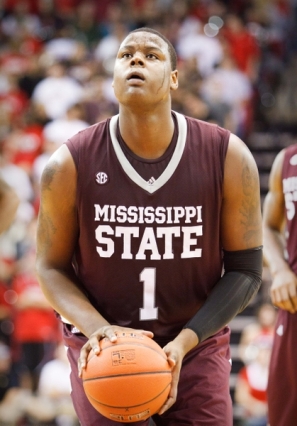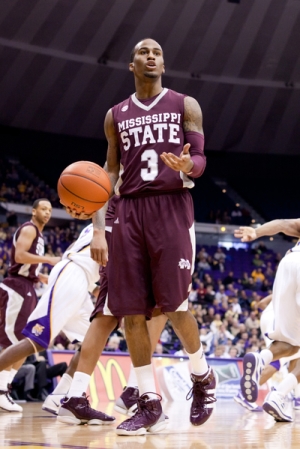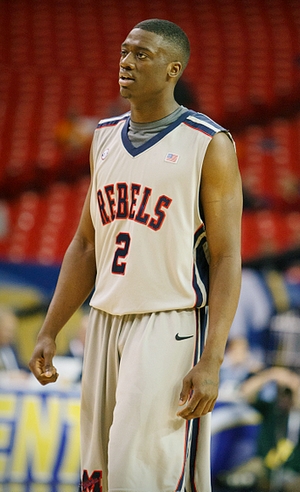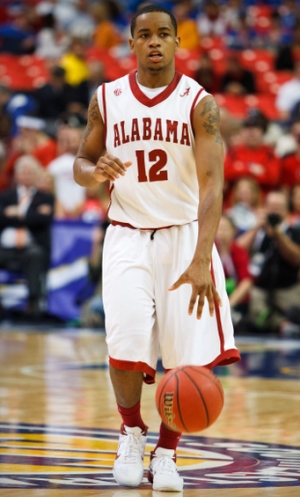Freshmen have been excluded from these previews, as we'd like to wait and see what they have to offer on the NCAA level before we come to any long-term conclusions.
-Top 20 Prospects in the Big Ten
-Top 25 Prospects in the ACC
-Top 15 Prospects in the Big 12
-Top 15 Prospects in the Pac-12
-Top 25 Prospects in the Big East
-Top NBA Draft Prospects in the SEC, Part One (#1-10)
#11 Renardo Sidney, 6'10 , Power Forward/Center, Junior, Mississippi State

Kyle Nelson
There are few players more controversial than Mississippi State junior big man Renardo Sidney. After a season with more than a few off-the-court incidents, Sidney has his work cut out for him to prove that he is capable of living up to his lofty top-10 RSCI ranking.
Though Sidney more than looks the partstanding around 6'10 with long arms and huge hands he was very overweight as a freshman, and, even at his currently listed 280-pounds, could still stand to lose weight. His mobility and explosiveness would benefit, but so too would his poor conditioning. Though he is surprisingly mobile and explosive for his size, maximizing his physical potential would go a long way in convincing scouts that he is serious about playing in the NBA.
On offense, Sidney continues to show the potential that made him a prospect at such a young age, while simultaneously revealing some unfortunate tendencies. On paper, though, he had a productive sophomore campaign, averaging 14.2 points and 7.6 rebounds in just over 25 minutes per game.
Sidney is at his best in the post, where he sees 35.7% of his possessions. While his massive size and nimble footwork definitely gives him an advantage here, he also does a solid job of establishing post position and is capable of corralling errant passes with his soft hands. After backing his man down, he usually reverts to a jump hook, a turnaround jump shot, or simply spins towards to the basket. He gets to the foul line at a solid rate, where he makes over 70% of his attempts. Ultimately, while he must continue to improve, he already has an interesting low post repertoire at this stage.
He also looked comfortable operating out of the high post using his solid ball-handling skills and deceptive quickness to his advantage when facing his man up. He also looked very good in pick-and-roll opportunities, setting good picks while being equally comfortable rolling to the basket and finding spot-up looks on the perimeter.
His perimeter game is a mixed bag at this stage, largely due to his propensity to fall in love with his jump shot and his mediocre shot selection. Outside of his tendency to fade away, his mechanics are solid, however, and though his release can be inconsistent at times, he has good touch and 3-point range on his shot. Despite the potential he shows in this area, Sidney made just 34% of his jumpers last year.
Sidney's poor shot selection is one of many questions revolving around his decision-making ability on the offensive end of the floor. His 0.28 assist/turnover ratio, for instance, is one of the worst amongst prospects in our database Another concern seems to be his decidedly average court awareness. While it is possible that after sitting out a season and a half, he was simply rusty, that this lapse occurred at a key point in his development is concerning. Whether or not he can maintain focus and consistent effort on offense is an issue, as well, primarily moving better without the ball in his hands and working harder on the offensive boards.
Defensively, Sidney has a long way to go, but is better than advertised. For one, his massive frame, impressive length, and mobility help him guarding his man in the post. Though he struggles to keep his man from receiving the ball, he improved at holding his position as the season progressed. Similarly, he is a solid rebounder, as well, grabbing 12 rebounds per 40 minutes, numbers that should only increase if he improves his effort level, conditioning and fundamentals.
Of significant concern, however, is his lack of defensive focus. Sidney oftentimes loses track of his man, fails to close out shooters or fight through screens, or simply stops trying if he's beaten. Proving to scouts that these issues were related to conditioning and immaturity is essential, especially given his reputation as an uninterested defender.
Finally, it would be negligent to not mention the plethora of red flags that have haunted Sidney since his high school days. Even following his bizarre recruitment and a televised fight with a teammate, he continued to attract negative headlines this summer. He spent time with John Lucas to address his off-court issues, and received good reports for his conduct there.
Ultimately, there are few big men in the NCAA with Sidney's combination of size and skill. Whether or not he is able to turn that into a stellar junior campaign remains to be seen, especially given the eligibility of the similarly perimeter-infatuated power forward prospect and teammate Arnette Moultrie. Mississippi State's success this season likely depends on Sidney's success, however, and scouts and sportswriters alike will be scrutinizing his every move to see if he has truly overcome his unfortunate reputation. After all, there is no doubting his talent and potential; his overall effort and intangibles, on the other hand, must improve considerably if he wants to play at the next level.
#12, Dee Bost, 6'2, Senior, PG, Mississippi State

Derek Bodner
Since declaring for the NBA draft after his sophomore year Mississippi State senior point guard Dee Bost has struggled, both on and off the court.
The 6'2 Bost started off his junior year academically ineligible for the first semester, then followed that up with a 9 game suspension from the NCAA, the first victim of the NCAA's new NBA draft deadline which would have required Bost to withdraw from the NBA draft by May 8th.
With Bost's suspensions, along with Renardo Sidney's suspension, MIssissippi State never found its rhythm, struggling to a 17-14 record, its worst since 2006.
Individually, Bost's season was up and down. Bost did an excellent job setting up his teammates, and his 7 assists per 40 minutes ranks in the top 10 in the NCAA last year, and he appears to be a lock to end up as Mississippi State's all-time assist leader. He was also in the top 10 in turnovers per 40 minutes and appeared to regress as a shooter, struggling with his consistency, both with his feet set and off the dribble. His shot selection is, and always has been suspect, forcing up too many contested off the dribble jumpers, often early in the shot clock.
He is not an efficient scorer inside (45% 2P) or outside (34% 3P) the arc, which helps explain his team's struggles to win games even with him, Renardo Sidney and Ravern Johnson in the lineupon paper clearly a NCAA tournament caliber team.
In the half-court, Bost prefers to operate in pick and roll sets, something that has been true for his entire duration at Mississippi State. Bost shows the ability to make shots off the pick and is able to use his quickness and ball handling to get into the lane in these sets.
Bost has good quickness and is able to change directions with his handle, and does a good job of getting into the lane. He has good body control, but at times struggles to finish through contact. He combats this somewhat with an array of floaters in the lane, but his primary weapon once in the lane is the pass, both to spot-up shooters on the perimeter and cutters around the basket.
Bost operates primarily with the ball in his hands, but in the opportunities he has as a spot-up shooter it appears this is a part of his game that could be of value at the next level when he's not asked to create as much as he currently is. With his feet set and space to operate, Bost's consistency in his jump shot improves considerably. He does a good job of squaring up, gets good elevation and shows a consistent release.
As good as Bost's court vision is, his carelessness with the basketball somewhat offsets this, a problem that has only gotten worse with time. The reasons for his turnovers are varied, from trying to do too much, to lack of focus, to simply bad decisions.
Defensively, Bost is a mixed bag. He has decent length at the point, but will be undersized, both in length and in bulk, if defending off the ball. He moves his feet adequately well defensively, but sometimes gets caught in too upright, and struggles to fight through picks and screens. He has good hands defensively, and does a good job of forcing turnovers.
By all accounts, Bost appears poised to have a big season, and Mississippi State looks to bounce back from a disappointing 2010-2011 campaign. Bost has some tools that could draw interest at the next level, particularly with his quickness and passing ability, but he needs to improve his decision making, and scoring efficiency to make the next jump as a prospect. Missing the first 14 games of the season last year may have hurt Bost's comfort level and timing with his teammates, particularly with talented newcomer Renardo Sidney. With better conditions to start the season, Bost's improvement in these areas will be key for his NBA prospects, and for the Bulldogs' success.
#13 Kenny Boynton, 6'2 , Shooting Guard, Junior, Florida
Not having made a great deal of progress from his freshman season, which we profiled with a comprehensive scouting report, we've elected to wait and see what type of progress Boynton has made with a fresh perspective in a few months, rather than rehashing many of the same comments made last year based off his 2010-2011 game footage.
#14 Reginald Buckner, 6-8, Junior, Power Forward, Ole Miss
Jonathan Givony

A highly touted high school recruit, Reginald Buckner took some time to develop under Andy Kennedy, but could be on the verge of a breakout junior season at Ole Miss.
Despite possessing average height at 6-8, Buckner compensates for that from a physical standpoint with a terrific frame, a huge wingspan and very good athleticism. He runs the floor well when motivated, is agile with his movements, and elevates exceptionally well around the rim on both ends of the floor, sometimes in highlight reel fashion.
Buckner looks like a more talented scorer on film than his 7 points per game would indicate, as hinted by his 59% conversion rate from the field. This may be partially due to the lack of playmaking and offensive cohesion his team suffered from last season, as there was no one to create easy opportunities and take advantage of his excellent potential as a finisher around the basket.
More than just a run-jump athlete, his skill-level shows promise, as he can attack his matchup a bit off the dribble with a quick first step and decent ball-handling skills, and has some nice spin moves he can utilize inside the paint. He was able to do some damage with his back to the basket in the SEC last year as well thanks to his excellent physical tools, but may not have the size or bulk to translate that to the NBA level unless he significantly improves his footwork, left hand and countermoves.
Buckner also doesn't have any type of perimeter game at this stage, making just one jump-shot on the season and converting a dismal 44% of his free throws. Considering his likely role in the pros, this is something he would be well suited to work on.
Defensively, Buckner shows both extreme strengths and weaknesses. On one hand he ranks as the #1 shot-blocking prospect in college basketball, thanks to his terrific length, athleticism and anticipation skills.
On the other hand, he doesn't do much to help his team get stops outside of the rejections he produces, as he's decidedly average in every other facet of defense.
His effort level and fundamentals are sub-par at best, as he gives up deep post position in the paint at will, and looks extremely lethargic off the ball. He struggles to step out on the perimeter and stay in front of his defender, and will regularly get beaten up the floor by opposing matchups who have likely scouted his lackadaisical tendencies on film.
Buckner's length and athleticism makes him a significant factor on the offensive glass, but his rebounding production as a whole is just average relative to his role and potential, a product of his lack of hustle.
He struggles to stay on the floor due to foul trouble, averaging 6.3 fouls per-40 minutes, as he regularly gets caught out of position and ends up biting on pump-fakes.
Only going into his junior year, Buckner still has time to improve his fundamentals and change his reputation as an underachiever. Players in his mold are extremely coveted at the professional level, and if the light bulb ever comes on and he finds the motivation needed to reach his potential, he could be an asset in the right situation.

A highly touted high school recruit, Reginald Buckner took some time to develop under Andy Kennedy, but could be on the verge of a breakout junior season at Ole Miss.
Despite possessing average height at 6-8, Buckner compensates for that from a physical standpoint with a terrific frame, a huge wingspan and very good athleticism. He runs the floor well when motivated, is agile with his movements, and elevates exceptionally well around the rim on both ends of the floor, sometimes in highlight reel fashion.
Buckner looks like a more talented scorer on film than his 7 points per game would indicate, as hinted by his 59% conversion rate from the field. This may be partially due to the lack of playmaking and offensive cohesion his team suffered from last season, as there was no one to create easy opportunities and take advantage of his excellent potential as a finisher around the basket.
More than just a run-jump athlete, his skill-level shows promise, as he can attack his matchup a bit off the dribble with a quick first step and decent ball-handling skills, and has some nice spin moves he can utilize inside the paint. He was able to do some damage with his back to the basket in the SEC last year as well thanks to his excellent physical tools, but may not have the size or bulk to translate that to the NBA level unless he significantly improves his footwork, left hand and countermoves.
Buckner also doesn't have any type of perimeter game at this stage, making just one jump-shot on the season and converting a dismal 44% of his free throws. Considering his likely role in the pros, this is something he would be well suited to work on.
Defensively, Buckner shows both extreme strengths and weaknesses. On one hand he ranks as the #1 shot-blocking prospect in college basketball, thanks to his terrific length, athleticism and anticipation skills.
On the other hand, he doesn't do much to help his team get stops outside of the rejections he produces, as he's decidedly average in every other facet of defense.
His effort level and fundamentals are sub-par at best, as he gives up deep post position in the paint at will, and looks extremely lethargic off the ball. He struggles to step out on the perimeter and stay in front of his defender, and will regularly get beaten up the floor by opposing matchups who have likely scouted his lackadaisical tendencies on film.
Buckner's length and athleticism makes him a significant factor on the offensive glass, but his rebounding production as a whole is just average relative to his role and potential, a product of his lack of hustle.
He struggles to stay on the floor due to foul trouble, averaging 6.3 fouls per-40 minutes, as he regularly gets caught out of position and ends up biting on pump-fakes.
Only going into his junior year, Buckner still has time to improve his fundamentals and change his reputation as an underachiever. Players in his mold are extremely coveted at the professional level, and if the light bulb ever comes on and he finds the motivation needed to reach his potential, he could be an asset in the right situation.
#15 Trevor Releford, Soph., 6'1, Point Guard, Alabama

Jeff Rush
Trevor Releford may not have been as highly touted as his older brother, and current Kansas wing, Travis, was coming out of high school, but the point guard exceeded expectations for the Crimson Tide as a freshman. Releford was handed the reins of Alabama's offense from day one by Head Coach Anthony Grant, and proved to be a capable point guard at the high-major level, finishing first on the team in assists and third in scoring. Despite his productive freshman season, Releford has plenty of things of to work on to improve his professional outlook down the road.
Somewhat undersized at just 6-1, Releford feeds off of getting the ball and getting out in transition. He does a tremendous job increasing the pace of the game and often makes transition opportunities out of nothing. While in transition he does a great job weaving across the floor, especially from the right side to the left, and using the traffic in the middle to get to the rim. He stays very low as he pushes the ball and is capable of creating attempts at the rim by running his defender into other players who are simply retreating to the defensive end.
In the half court, Alabama often goes to the pick and roll for Releford when they can't get anything out of their sets and count on him creating opportunities for himself and others. Releford prefers to use the high screen and turn the corner to get all the way to the basket as opposed to pulling up for jump shots or shooting floaters in the lane.
With a full head of steam, Releford is quick enough to get to the rim, but his inability to change speeds in the half-court makes it difficult for him to maneuver around defenders at times, forced him to put up difficult shots or make passes that aren't there. When Releford learns to be effective at a slower pace he will be able to pick and choose his spots to explode in transition and get easier shots for himself and his teammates.
Additionally, he really struggles when shooting off the dribble, converting only 25.6% of his pull-up jumpers according to Synergy Sports Technology, which is nearly 10% lower than off of catch and shoot opportunities. In order to maximize his pro potential Releford will have to improve his shot selection and consistency as a shooter moving forward.
As a point guard, Releford is still trying to reconcile his natural scoring instincts with putting the team in the best position to score. He will show flashes of playmaking at times but does not do it consistently enough at this point in his career, which is somewhat understandable considering his lack of experience being thrown straight into the SEC fire already as a freshman.
Alabama was one of the best teams in the country defensively last year, and Releford was a key component in that. He used his quick feet and hands to disrupt the opponent's ball handlers, excelling in causing turnovers that were used to get the Crimson Tide out on the break. Much like on the offensive end Releford can effectively use his aggressiveness, but he is a little bit too much high risk-high reward. He does cause a lot of turnovers, but he must learn the right times to attack and the right times to play solid and force a tough shot. Considering that he's already undersized for a NBA point guard, he doesn't have a huge margin for error.
Overall, Releford was one of the more productive freshmen point guards in the BCS conferences, something that is worth taking note of. To reach the highest level he will have to learn to change pace during the course of a game, improve his perimeter shooting and develop his playmaking instincts. It will be interesting to see how Releford matures with the experience he gained as a freshman starter on a team that made the NIT Championship game, and whether he can take his game to the next level and develop into a true NBA prospect over the next year or two.



































Comments